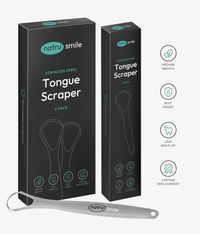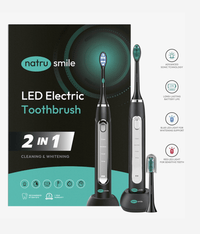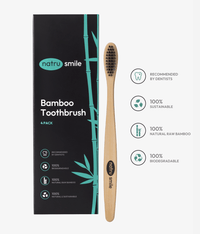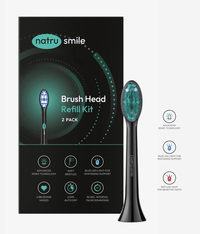
All products are certified by dental expert Dr. Greg Grillo
Tooth decay and dental caries impact 90% of the population, making it one of the most common dental issues individuals face. While some of these conditions go untreated and others are treated with fluoride (or root canal treatment in extreme cases), many require dental fillings.
Fillings are a common way to protect the tooth from further decay and restore its appearance and function. And while they are a great solution to the problem, many people face the problem of yellow teeth months or years after the filling has been placed.
The reality is that some teeth whitening options won't work at all, but there are options for those who want to whiten their teeth with fillings. In this article, we'll tell you all you need to know about how dental fillings impact teeth whitening and the best solutions available.
What Are Dental Fillings, And How Do They Work?
Dental fillings are used to repair teeth that have been damaged by decay or cavities. They’re made up of a composite material, which can be white or tooth-colored, and they create a seal around the cavities in the teeth. This allows them to protect the tooth from any further damage and restore its shape, size, and appearance.
Most people require dental fillings at some point in their lives, and there are several reasons for this:
- Tooth decay
- Cavities
- Chipped or broken teeth
- Worn-down areas of the teeth
Sometimes, the need for fillings could have been prevented. But other times (like in the case of broken teeth), fillings result from a complete accident.
If you find yourself needing dental fillings, the process looks like this:
- Your dentist will clean the affected area to remove any bacteria and debris that could be present.
- They’ll fill the cavity or missing tooth area with a composite material.
- The material is then shaped, smoothed, and polished for a natural look and feel.
- Finally, your dentist will apply a sealant to the filling to further protect it from bacteria.
Once your dentist is done, you’ll have a restored and healthy smile that should last for years with proper care.
Can You Whiten Teeth With Dental Fillings?
The short answer is maybe - you can sometimes whiten teeth if you have dental fillings. But the effectiveness of doing so will depend on how much of your original tooth enamel remains. If the composite material of the filling covers most (or all) of your natural tooth, then whitening will be impossible.
Since only natural teeth can be whitened, teeth whitening procedures will only be valuable for individuals with fillings underneath or behind the front of their teeth. If they have fillings covering the front, the whitening procedure will have no cosmetic impact on the visible portions of the teeth.
In short, teeth whitening does not work on dental fillings. But those with dental fillings can still benefit cosmetically from teeth whitening if the fillings aren’t on a visible part of the tooth.
Whitening Options For People With Dental Fillings
If the visible parts of your teeth are complete (without any gaps, chips, or fillings), then whitening your teeth is a viable option. There are several ways to enjoy the benefits of a whiter smile, though it’s important to keep in mind that the results will vary from person to person.
Here are some of the most common teeth whitening procedures for people with dental fillings:
At-Home Teeth Whitening Kits
At-home teeth whitening is the most popular choice for many people. These kits contain whitening strips or gels that you can easily apply to your teeth at home.
The active ingredient in these products is hydrogen peroxide, which helps lighten the color of your teeth over time.
There are two types of at-home kits:
- Professional Whitening: If you visit your dentist, they can provide you with a professional teeth whitening regimen, complete with a custom-fitted mouthguard and a professional-grade whitening gel. These kits are more potent than their over-the-counter counterparts, so they tend to achieve better results in less time.
- Over-the-Counter Kits: If you don't want to visit your dentist, you can purchase an over-the-counter teeth whitening kit from any drugstore. These kits typically contain whitening strips and a weaker concentration of hydrogen peroxide, but they still do the job for most people.
Many users prefer these methods to professional whitening because the at-home whitening cost is much lower than that of a professional procedure.
But home whitening is also error-prone since there is no one to guide you on the proper way to apply the strips and whitening gels. For this reason, it's important to pay close attention to the instructions and follow the guidelines provided in each kit.
In-Office Teeth Whitening
For individuals who want a more dramatic change in their smile, professional teeth whitening is an attractive option. This procedure typically involves several office visits and uses a stronger concentration of hydrogen peroxide to achieve faster, more dramatic results.
In-office teeth whitening is generally more expensive than at-home kits, but it can also produce longer-lasting results. Plus, because a professional will be monitoring the procedure and providing guidance throughout, you’re less likely to experience any adverse side effects.
Teeth Whitening Toothpaste
Teeth whitening toothpaste is another popular option for people with dental fillings. These kinds of toothpaste contain abrasive particles that help remove surface stains and make your teeth look brighter. However, they won’t change the color of your teeth as dramatically as professional whitening procedures or at-home kits can.
When using a whitening toothpaste, remember to only use it for about 4-6 weeks. Some research shows that when used too long or incorrectly, teeth whitening toothpaste can cause enamel erosion.
Natural Teeth Whitening Procedures
For those looking for a more natural way to whiten their teeth, there are a few options. Here are some of the most popular:
- Brushing with baking soda or hydrogen peroxide twice daily
- Oil pulling, which involves swishing a tablespoon of oil in your mouth for 20 minutes
- Avoiding staining foods, such as coffee and tea
- Drinking plenty of water to flush out any bacteria or debris in the mouth
- Using turmeric, which acts as a natural bleaching agent
Some types of natural teeth whitening - such as baking soda and hydrogen peroxide - are heavily researched and have been proven to be safe and effective. But most other methods have little more than anecdotal evidence behind them, so remember to do your own research before trying anything new.
Options For Patients Who Can't Whiten
Unfortunately, not everyone can use teeth whitening procedures. People with certain dental issues - such as crowns, veneers, bridges, and cosmetic fillings - cannot whiten their teeth with any of the methods described above.
However, there are a few options available to those individuals.
Replace Your Dental Work With New Fillings
If you have silver amalgam fillings (like many people of older generations do), you may be able to get them all replaced with composite fillings. Composite fillings are tooth-colored and look more aesthetically pleasing. If you decide to do this, you can whiten your teeth beforehand and get the new fillings placed over them.
Ask Your Dentist About Porcelain Veneers Or Crowns
If you have existing dental issues that can’t be addressed with whitening, your dentist may suggest porcelain veneers or crowns. These custom-made shells cover the existing teeth, providing a much brighter and more uniform smile. This option is more expensive than whitening, but it can give you the dramatic long-term results you’ve been looking for without any of the teeth whitening side effects.
Have Your Teeth Professionally Cleaned
Even if you can’t whiten your teeth, having them professionally cleaned can help remove surface stains and make them look brighter. It isn't the most visibly dramatic way to improve your smile, but it's a good choice if you don't want to go through the hassle of paying for new fillings or veneers.
Want to know more? Here are a few questions our customers frequently ask us:
How Can I Whiten Fillings On My Front Teeth?
Unfortunately, whitening fillings on your front teeth is not possible. Your best option would be to replace those fillings with composite (tooth-colored) fillings or consider porcelain veneers or crowns for a better aesthetic result. Patients who decide to replace their fillings can remove the old ones, whiten their teeth, and then place the new fillings over them to match the whiter shade.
Can I Whiten My Teeth If I have A Cavity?
Yes, you can still whiten your teeth if you have a cavity. However, it’s important to make sure that the tooth is healthy and stable before undergoing any kind of whitening procedure. You should also bear in mind that although teeth whitening is safe, it may cause sensitivity, which your cavity could exacerbate.
How Do I Whiten Fillings On Teeth At Home?
There is no at-home procedure that enables you to whiten your teeth fillings. However, whitening strips, gels, toothpaste, and mouthwash are all viable options for whitening teeth as long as the fillings do not cover the visible parts of the teeth. Additionally, flossing, brushing, and using mouthwash regularly can help remove surface stains, making your teeth look brighter.
Will Whitening Products Work On Dental Fillings?
Since whitening products are not made of tooth enamel, they don't change color. This means that they won't have any effect on dental fillings. The only way to make your teeth whiter with fillings is to replace them with composite (tooth-colored) fillings or consider porcelain veneers or crowns.
Will Baking Soda Whiten Fillings?
Baking soda can whiten the areas around fillings (i.e., the tooth enamel), but it will not whiten the fillings themselves. To make the teeth whiter with fillings, you will need to whiten your teeth and replace the fillings with ones that match the whiter shade.
Should I Get Fillings Before Or After Whitening?
If you need to get dental fillings on a visible part of your smile, you should whiten your teeth before getting the fillings. This way, the shade of the new filling can be matched to the newly whitened teeth for a more aesthetically pleasing result.
Keep in mind that if you do this, you will need to maintain that same shade of white. Otherwise, your fillings will stand out.
How Long Do Dental Fillings Last?
Dental fillings usually last around ten years. However, many restorations last longer than this. The lifespan of a filling will depend on its size, the type of material it’s made out of, and the amount of wear and tear it gets. It’s important to monitor your fillings regularly so you can get them replaced if necessary.
Wrapping Up
Having dental fillings doesn’t mean you can’t enjoy the benefits of a whiter smile.
Although whitening products don’t work on fillings, there are other ways to make your teeth look brighter. Replacing your existing fillings with composite (tooth-colored) fillings is a good option if you don’t want to go through the hassle of getting veneers or crowns. But veneers are the best way to whiten your smile without dealing with the duration of teeth whitening.
Regardless of the method, it’s important to make sure that your teeth are healthy and stable before whitening them. We recommend consulting with a dentist before attempting any kind of at-home tooth whitening procedure. That way, you can be sure that your pearly whites will stay in top condition for years to come.










